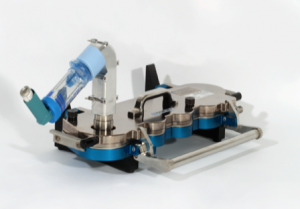Q: What further advances may we see in the future to improve the clinical relevance of testing spacers/VHCs?

Figure 4: Accessories such as the child version of the Alberta Idealized Throat (shown on NGI, top) and Mixing Inlet with a Breathing Simulator (bottom) can be used to make aerodynamic particle size distribution (APSD) testing more representative of clinical conditions.
For example, a mixing inlet decouples the flow rate applied through an inhaler during testing from that drawn into the cascade impactor, making it possible to apply a low flow rate (in the case of pediatric relevant testing) or a tidal breathing pattern (with a breathing simulator) through the device, while maintaining a constant flow rate, at a calibrated value, through the impactor.
Using a mixing inlet therefore overcomes the limitations of a cascade impactor being a constant flow rate device and allows APSD tests to be undertaken using clinically relevant breathing profiles, applicable to the required patient category.
The pharmacopeial test methods use the standard USP induction port, which is used with cascade impactors for all types of orally inhaled product testing. However, the standard induction port commonly underestimates the amount of drug deposited in the throat, so using alternative induction ports can facilitate better in vitro-in vivo relationships.
More realistic throat models employing clinically realistic geometry can be used as a better predictor of in vivo performance and is referenced in the chapter as a way to enhance clinical relevance (Figure 4).
Mark Copley graduated from the University of Bath, UK in 2000 with a Masters Degree in Aerospace Engineering. For 8 years he was Technical Sales Manager and product specialist for Copley Scientific’s range of inhaler testing equipment and is now CEO of the company. Mark is considered a leading authority in testing methods and systems for metered-dose inhalers, dry powder inhalers, nebulisers and nasal sprays; authoring and contributing to more than 40 published articles. He also provides application support and consultancy, runs focused training workshops for the inhaled drug testing sector of the pharmaceutical industry and sits on the editorial advisory panel of Inhalation Magazine. An invited member of the European Pharmaceutical Aerosol Group (EPAG) impactor sub-team, Mark has also made recommendations to the Inhalanda working group, leading to subsequent revisions to Ph. Eur. and USP monographs.


